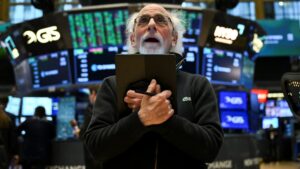The Great Short Squeeze: Understanding the Market Dynamics Behind the Historic Rally
On April 9, 2025, the trading floor of the New York Stock Exchange buzzed with an unprecedented energy as stocks surged, culminating in one of the most extraordinary trading days in financial history. Hedge funds and traders alike were caught in a whirlwind, witnessing a remarkable phenomenon known as a "short squeeze" that turned intrepid investors into anxious market participants scrambling to cover their bets.
What Sparked the Surge?
The frenzy was ignited by President Donald Trump’s announcement of a pause in the steep tariffs initially set to impact the market. Just prior to this news, hedge funds had amassed record short positions, anticipating a drop in share prices amidst escalating trade tensions. Short selling is a strategy where investors borrow securities to sell at current prices, hoping to buy them back at lower prices once the stocks decline. However, this approach carries inherent risks that can quickly spiral out of control when market conditions shift dramatically.
The Anatomy of a Short Squeeze
As the news broke and stocks began to soar, those who had bet against the market found themselves in hot water. In an effort to limit their losses, hedge fund traders rushed to buy back the stocks they had borrowed—a rapid regrouping that propelled prices upward even further. This event—a short squeeze—drew in new investors and traders, pushing the S&P 500 to record gains, marking its third-largest single-day jump since World War II.
A Surge in Trading Volume
The trading session saw a staggering volume of 30 billion shares exchanged—a record-breaking statistic reflecting the chaotic nature of the day’s events. With the S&P 500 gaining a remarkable 9.5%, commentators noted that the surge was amplified by not just short-covering activities but also significant buying interest from long-only funds, particularly within the tech sector.
The Role of Market Psychology
Market sentiment also played a crucial role. As liquidity in trading markets thinned, every buying or selling action had an outsized impact on stock prices. This is reflected in the shocking phrase from Jeff Kilburg, CEO of KKM Financial, who noted, “When you see someone short covering, the exit doors become so small because of these crowded trades.” Indeed, what transpired on April 9 was not merely a financial occurrence but a psychological one, highlighting the levels of anxiety and reactionary behavior prevalent among investors.
Looking Ahead: What Comes Next?
While the immediate effects of the short squeeze sent tremors through the financial world, questions remain about the market’s stability. As investors processed the implications of Trump’s tariff revisions, there was a palpable pullback on April 10, revealing the underlying tensions that still lurk within the economy.
Analysts warn that the specter of high tariffs and the unpredictability of international negotiations could set the stage for another wave of volatility. Moreover, large short positions remain; some traders believe that as the market attempts to rally again, we may witness a continuation of the short-covering frenzy.
Conclusion: Learning from Market Dynamics
At Extreme Investor Network, we understand that trading is not just a numbers game—it’s a complex interplay of psychology, market sentiment, and strategic positioning. The events of April 9 serve as a reminder to investors about the importance of being mindful of market dynamics, including the risks associated with short selling.
In this rapidly changing environment, developing a robust investment strategy is more crucial than ever. By staying informed and receptive to emerging trends, investors can navigate the markets successfully, turning potential challenges into opportunities for growth. Explore our resources and expert insights at Extreme Investor Network to equip yourself with the knowledge necessary to thrive in today’s financial landscape.

